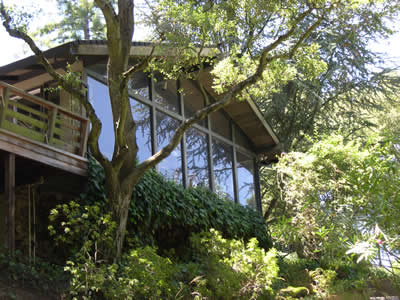Trees
Trees
Trees have many beneficial qualities, including their ability to absorb solar radiation and provide shade. Unfortunately, a tree that is overhanging a home can cause physical damage to the house from branches rubbing on the roof or walls, and more importantly from a fire perspective, leaf and needle drop will result in greater accumulation of debris on the roof, in gutters, and on decks and surrounding landscape. For these reasons, it is recommended to remove trees or branches that overhang any roof or deck. A healthy and lush green tree canopy itself is not necessary immediately flammable or receptive to embers.
To maintain the benefits of the shade tree while simultaneously increasing fire safety, move trees back to Defensible Space Zone One, prune the lower limbs, and eliminate vegetation, vines, and other dead fuels that would allow for fire to move from the ground to the upper portion of the tree (i.e., the tree crown). If a tree is diseased or showing signs of decline, consider its removal or replacement.

The crown of a tree should be at least 10 feet away from the nearest structure. This reduces the volume of litter drop on the roof and deck, reduces the potential for falling branches to damage the roof, and protects the foundation from root growth.
As plants and trees age they shed bark, limbs, and leaves. These materials become fuels over time. Keep in mind that some tree and shrub species, such as Italian Cypress and junipers, can easily mask their dead materials. Gardeners often miss dead accumulations that can easy be ignited by embers or flames. Maintenance of vegetation near the home is critical.



